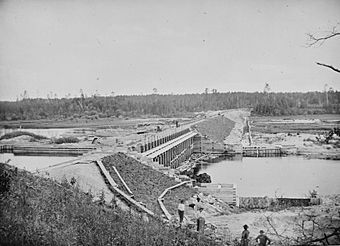Winnibigoshish Lake Dam facts for kids
Quick facts for kids |
|
|
Winnibigoshish Lake Dam
|
|

Construction of the original 1884 dam
|
|
| Location | Cass / Itasca counties, Minnesota |
|---|---|
| Nearest city | Deer River, Minnesota |
| Built | 1899 |
| NRHP reference No. | 82004629 |
| Added to NRHP | May 11, 1982 |
The Winnibigoshish Lake Dam was first built between 1881 and 1884. Its main job was to control the water flow on the Upper Mississippi River. The United States Army Corps of Engineers built it to help people like loggers, fur traders, and millers who needed a steady water supply downstream.
The dam is located in Minnesota, crossing the line between Cass County and Itasca County. It is also within the Leech Lake Indian Reservation. The dam helped create Lake Winnibigoshish, which is Minnesota's fifth largest lake. It covers about 67,000 acres (271 square kilometers).
How the Dam Changed the Area
When the first dam was built, the area was mostly home to the Ojibwa people. They had lived along the river for many generations. An explorer named Henry Schoolcraft wrote about their lives there.
The U.S. Army Corps of Engineers used a lot of pine wood for the dam. This meant cutting down many conifer trees. Along the riverbanks, the Ojibwa people had their hay fields, maple trees, gardens, cranberry marshes, and wild rice marshes. They also had villages and burial mounds.
Fish were a very important part of their diet. They caught fish using nets in the fast, shallow river. But when the dam was built, it raised the water level by about 14 feet (4.3 meters). This covered their homes and fishing spots. It had a huge impact on the Ojibwa people's way of life and their history.
Archaeologists have found old ceramic pieces and burial mounds in the area. These date back to between 700 and 1000 CE. The dam's construction was a big moment in history. It showed how new settlers and businesses changed the lives of the native people in Minnesota.
The New Dam and Today
The dam you see today was built in 1899. It replaced the original 1884 wooden dam. The new dam was made with concrete, which is much stronger. This 1899 dam is now listed on the National Register of Historic Places.
By the 1920s, many Minnesotans started visiting the area. They came to enjoy camping, fishing, and hunting. Places like the Northlands Camp built hotels, cabins, and stores for all the tourists.
Today, many locks and dams help control the water level on the Upper Mississippi River. This makes it easier for boats to travel and helps prevent floods. Tourism is still a very important part of the local economy in the area.
Images for kids




